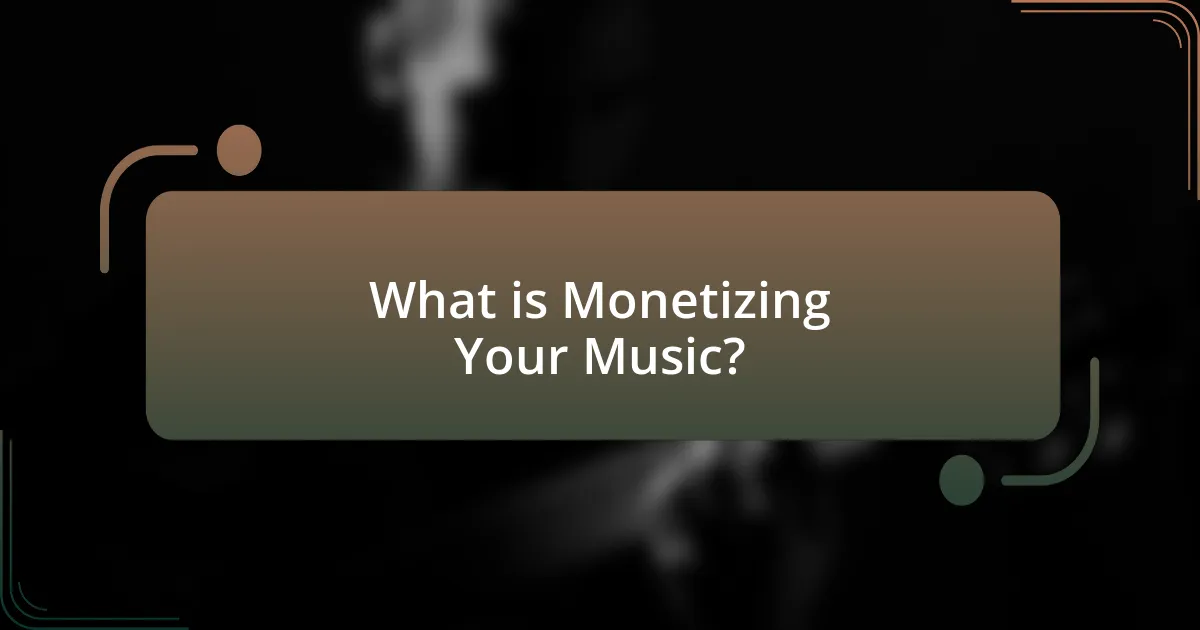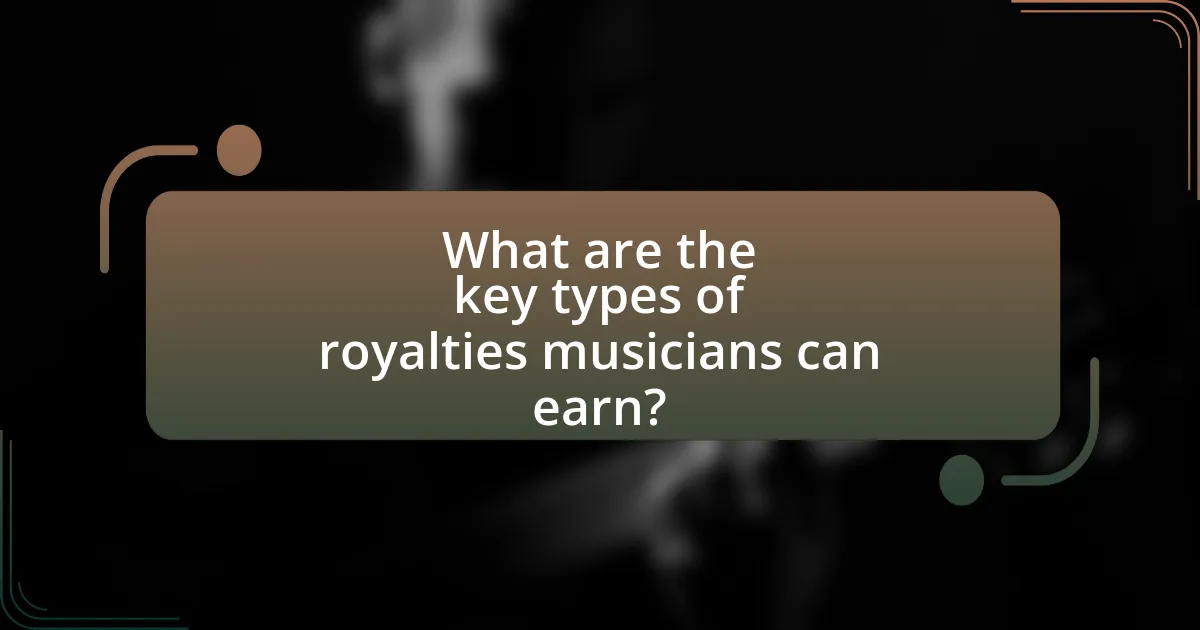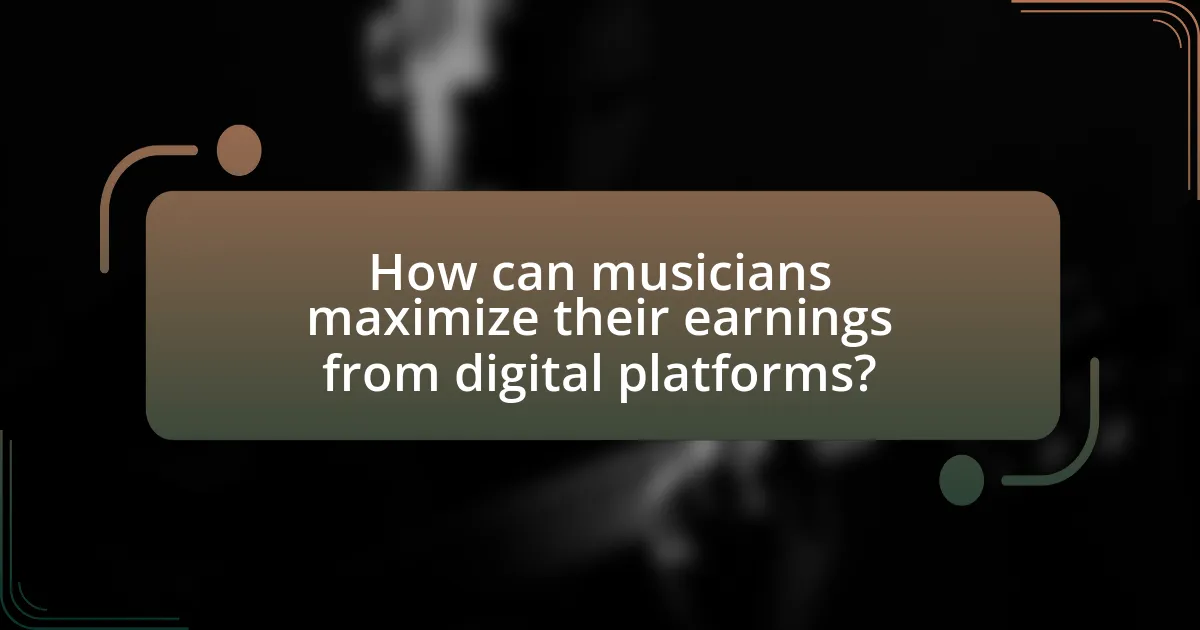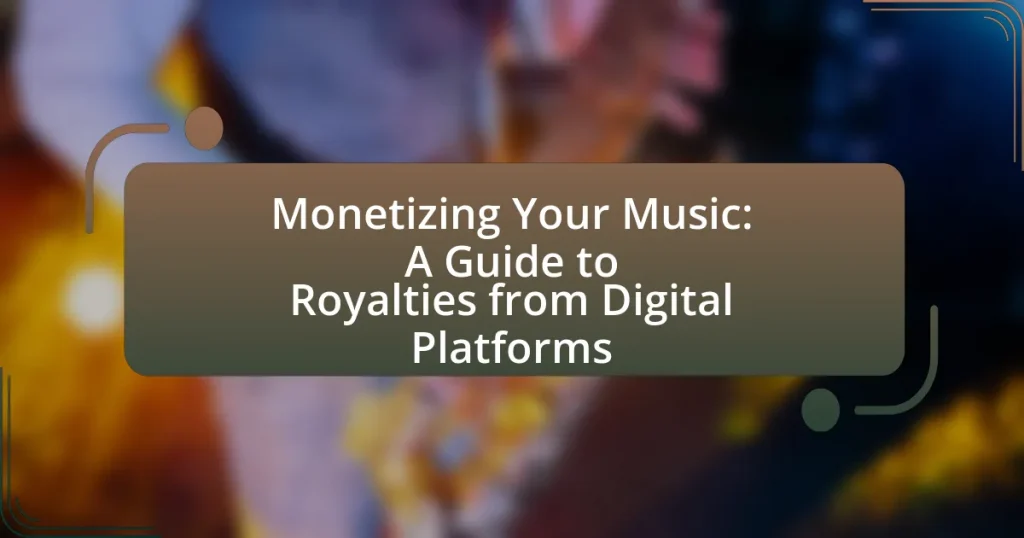Monetizing your music involves generating revenue from musical creations through various channels, including streaming services, live performances, merchandise sales, and licensing. The article outlines how musicians can earn money through different revenue streams, such as streaming royalties, performance fees, and mechanical royalties, while emphasizing the importance of understanding royalties for financial sustainability. It also discusses the role of digital platforms in facilitating music monetization, the calculation and distribution of royalties, and best practices for tracking earnings. Additionally, the article highlights common pitfalls musicians should avoid and practical tips for enhancing revenue in the evolving music industry landscape.

What is Monetizing Your Music?
Monetizing your music refers to the process of generating revenue from your musical creations. This can be achieved through various channels such as streaming services, digital downloads, live performances, merchandise sales, and licensing for film, television, or advertisements. According to the Recording Industry Association of America (RIAA), in 2022, streaming accounted for 83% of the U.S. music industry’s revenue, highlighting the significance of digital platforms in monetization strategies.
How can musicians earn money from their music?
Musicians can earn money from their music through various revenue streams, including streaming royalties, live performances, merchandise sales, and licensing deals. Streaming platforms like Spotify and Apple Music pay artists based on the number of streams their songs receive, with the average payout per stream being approximately $0.003 to $0.005. Live performances generate income through ticket sales, with the global live music industry valued at over $30 billion in 2019. Merchandise sales, such as T-shirts and albums, provide additional revenue, often contributing significantly to an artist’s income. Licensing deals allow musicians to earn money by having their music featured in films, commercials, or video games, with fees varying widely based on the project’s scope and budget.
What are the different revenue streams available for musicians?
Musicians have several revenue streams available, including album sales, streaming royalties, live performances, merchandise sales, licensing for film and TV, and crowdfunding. Album sales generate income through physical and digital purchases, while streaming royalties come from platforms like Spotify and Apple Music, which pay artists based on the number of streams. Live performances provide significant revenue through ticket sales and performance fees. Merchandise sales, such as clothing and accessories, contribute additional income. Licensing music for film, television, or commercials can yield substantial payouts, and crowdfunding platforms allow fans to support musicians directly, often in exchange for exclusive content or experiences. These diverse revenue streams enable musicians to monetize their work effectively in the evolving music industry landscape.
How do digital platforms facilitate music monetization?
Digital platforms facilitate music monetization by providing artists with access to a global audience and various revenue streams. These platforms, such as Spotify, Apple Music, and YouTube, enable musicians to distribute their music widely, allowing for streaming royalties, digital downloads, and advertising revenue. For instance, Spotify pays artists based on the number of streams their songs receive, with reports indicating that the average payout per stream is between $0.003 and $0.005. Additionally, platforms often offer tools for artists to track their earnings and audience engagement, enhancing their ability to monetize effectively.
Why is understanding royalties important for musicians?
Understanding royalties is crucial for musicians because it directly impacts their income and financial sustainability. Musicians earn revenue from various sources, including streaming services, radio play, and live performances, all of which generate royalties. For instance, in 2020, the U.S. music industry generated over $12 billion in revenue, with a significant portion coming from digital streaming royalties. By comprehending how these royalties are calculated and distributed, musicians can effectively manage their earnings, negotiate better contracts, and ensure they receive fair compensation for their work. This knowledge empowers them to make informed decisions about their music careers and financial planning.
What types of royalties exist in the music industry?
In the music industry, there are several types of royalties, including performance royalties, mechanical royalties, synchronization royalties, and print royalties. Performance royalties are earned when a song is played publicly, such as on radio, television, or live venues, and are typically collected by performance rights organizations like ASCAP or BMI. Mechanical royalties are generated from the reproduction of music, such as physical copies or digital downloads, and are often paid to songwriters and publishers by record labels. Synchronization royalties are earned when music is licensed for use in visual media, like films or commercials, and are negotiated between the rights holders and the producers. Print royalties come from the sale of sheet music and are paid to songwriters and publishers. Each type of royalty serves to compensate creators for the use of their work in various contexts.
How do royalties differ between digital and physical sales?
Royalties from digital sales typically differ from those of physical sales in terms of percentage and distribution methods. Digital sales often yield higher royalty percentages for artists, ranging from 60% to 80% of the sale price, as platforms like Spotify and Apple Music take a smaller cut compared to traditional physical sales, where artists may receive around 10% to 20% after costs like manufacturing and distribution are deducted. This discrepancy arises because digital sales eliminate many overhead costs associated with physical products, such as production and shipping, allowing for a more favorable revenue share for artists.
What role do digital platforms play in music monetization?
Digital platforms are essential in music monetization as they provide artists with avenues to distribute their music and generate revenue. These platforms, such as Spotify, Apple Music, and YouTube, facilitate streaming, downloads, and sales, allowing artists to reach a global audience. According to the Recording Industry Association of America (RIAA), streaming accounted for 83% of the U.S. music industry’s revenue in 2020, highlighting the significant financial impact of these platforms. Additionally, digital platforms often offer various monetization models, including subscription services, ad-supported streams, and direct sales, which enable artists to earn royalties based on their music’s consumption.
Which digital platforms are most popular for music distribution?
The most popular digital platforms for music distribution are Spotify, Apple Music, Amazon Music, and YouTube Music. These platforms dominate the market due to their extensive user bases and comprehensive music libraries. For instance, as of 2023, Spotify has over 500 million active users, making it a leading choice for artists to distribute their music and reach a global audience. Apple Music, with its integration into the Apple ecosystem, boasts over 88 million subscribers, providing significant exposure for artists. Amazon Music has also gained traction, with over 100 million subscribers, while YouTube Music leverages the vast reach of YouTube, which has over 2 billion logged-in monthly users. These statistics underscore the effectiveness of these platforms in facilitating music distribution and monetization for artists.
How do these platforms calculate and distribute royalties?
Digital platforms calculate and distribute royalties based on the number of streams, downloads, or sales of a song. Each platform, such as Spotify or Apple Music, uses specific algorithms to track user engagement and revenue generated from subscriptions or advertisements. For instance, Spotify pays artists a fraction of a cent per stream, with the total payout determined by the platform’s revenue and the artist’s market share of total streams. Additionally, platforms often retain a percentage of the revenue for operational costs before distributing the remaining amount to rights holders, which can include record labels, songwriters, and performers. This method ensures that royalties are allocated fairly based on actual consumption and revenue generated.

What are the key types of royalties musicians can earn?
Musicians can earn several key types of royalties, including performance royalties, mechanical royalties, synchronization royalties, and digital streaming royalties. Performance royalties are generated when a musician’s work is performed publicly, such as in concerts or on radio. Mechanical royalties arise from the reproduction of a musician’s work, typically through physical formats like CDs or digital downloads. Synchronization royalties are earned when a musician’s music is used in visual media, such as films or commercials. Digital streaming royalties are generated from platforms like Spotify or Apple Music, where musicians receive payment based on the number of streams their songs receive. These royalty types are essential for musicians to monetize their work effectively in the digital landscape.
What are performance royalties and how are they generated?
Performance royalties are payments made to songwriters, composers, and music publishers when their music is performed publicly. These royalties are generated through various channels, including live performances, radio broadcasts, television shows, and streaming services. Performance rights organizations (PROs) like ASCAP, BMI, and SESAC collect these royalties on behalf of the rights holders by monitoring public performances and distributing the collected funds based on usage data. For instance, in 2020, the U.S. music industry generated approximately $1.5 billion in performance royalties, highlighting the significance of this revenue stream for artists and songwriters.
Who collects performance royalties on behalf of musicians?
Performance royalties on behalf of musicians are collected by Performance Rights Organizations (PROs). PROs, such as ASCAP, BMI, and SESAC in the United States, monitor public performances of music and ensure that songwriters and composers receive compensation for their work. These organizations track performances across various platforms, including radio, television, and live venues, and distribute the collected royalties to the respective rights holders based on usage data.
How can musicians ensure they receive their performance royalties?
Musicians can ensure they receive their performance royalties by registering with a performance rights organization (PRO) such as ASCAP, BMI, or SESAC. These organizations track public performances of music and collect royalties on behalf of their members. By joining a PRO, musicians gain access to a system that monitors airplay, live performances, and streaming, ensuring they are compensated for their work. According to the U.S. Copyright Office, PROs distribute billions of dollars in royalties annually, highlighting the importance of registration for financial gain.
What are mechanical royalties and why are they significant?
Mechanical royalties are payments made to songwriters and music publishers whenever their music is reproduced in a physical format or digitally streamed. These royalties are significant because they provide a crucial revenue stream for creators, ensuring they are compensated for the use of their intellectual property. In the United States, the statutory rate for mechanical royalties is set at 9.1 cents per song per copy sold, which underscores their importance in the music industry’s financial ecosystem.
How are mechanical royalties calculated for digital downloads?
Mechanical royalties for digital downloads are calculated based on a statutory rate set by law, which is currently 9.1 cents per song for downloads in the United States. This rate applies to each copy of a song downloaded, meaning that if a song is downloaded 1,000 times, the mechanical royalties would total $9,100. The calculation is straightforward: the number of downloads is multiplied by the statutory rate to determine the total mechanical royalties owed to the songwriter or copyright holder. This system is governed by the Copyright Act, which ensures that songwriters receive compensation for the reproduction of their work in digital formats.
What is the process for collecting mechanical royalties?
The process for collecting mechanical royalties involves several key steps. First, songwriters and music publishers must register their works with a performance rights organization (PRO) or a mechanical rights organization, such as the Harry Fox Agency in the United States. This registration allows them to track the usage of their music. Next, when a record label or digital platform produces copies of the music, they are required to pay mechanical royalties to the rights holders based on the number of copies sold or streamed. The rate for mechanical royalties is typically set at 9.1 cents per physical copy sold in the U.S. for songs under five minutes, as established by the Copyright Royalty Board. Finally, the collected royalties are distributed to the songwriters and publishers according to their ownership shares, ensuring they receive compensation for the use of their music.
What are synchronization royalties and how do they work?
Synchronization royalties are payments made to songwriters and music publishers when their music is used in audiovisual works, such as films, television shows, commercials, or video games. These royalties are generated when a piece of music is synchronized with visual media, requiring a license to be obtained from the rights holder. The amount paid as synchronization royalties can vary based on factors such as the popularity of the song, the duration of its use, and the budget of the production. According to the U.S. Copyright Office, synchronization licenses are essential for legal use, ensuring that creators are compensated for their work in multimedia contexts.
What types of media typically use synchronization licenses?
Synchronization licenses are typically used in audiovisual media such as films, television shows, commercials, video games, and online content. These licenses allow the use of music in conjunction with visual elements, ensuring that the rights holders are compensated for the integration of their music into these media formats. For example, a popular song featured in a movie or a commercial requires a synchronization license to legally use the music alongside the visual content.
How can musicians increase their chances of earning sync royalties?
Musicians can increase their chances of earning sync royalties by actively pitching their music to music supervisors and licensing agencies. Engaging with these professionals allows musicians to showcase their work for potential placements in film, television, and advertisements. According to a report by the Music Licensing Collective, sync licensing has grown significantly, with revenues reaching over $1 billion in recent years, highlighting the lucrative opportunities available. Additionally, maintaining a diverse catalog of music that fits various genres and moods can enhance a musician’s appeal to a broader range of projects, further increasing their chances of earning sync royalties.

How can musicians maximize their earnings from digital platforms?
Musicians can maximize their earnings from digital platforms by leveraging multiple revenue streams, including streaming royalties, merchandise sales, and direct fan support through platforms like Patreon. Streaming services such as Spotify and Apple Music pay artists based on the number of streams, with Spotify reportedly paying between $0.003 and $0.005 per stream. Additionally, musicians can sell merchandise directly through their websites or platforms like Bandcamp, which allows them to retain a larger percentage of sales compared to traditional retail. Engaging with fans through social media and offering exclusive content or experiences can also drive direct support, enhancing overall earnings.
What strategies can musicians use to promote their music online?
Musicians can promote their music online through social media marketing, content creation, and digital distribution. Social media platforms like Instagram, Facebook, and TikTok allow musicians to engage with fans, share updates, and showcase their music through videos and live performances. Content creation, such as music videos, behind-the-scenes footage, and engaging posts, helps build a brand and attract a larger audience. Digital distribution services like DistroKid and TuneCore enable musicians to release their music on streaming platforms, increasing visibility and accessibility. According to a 2021 report by the International Federation of the Phonographic Industry, streaming accounted for 62% of global recorded music revenue, highlighting the importance of online presence for monetization.
How can social media impact music sales and streaming?
Social media significantly impacts music sales and streaming by enhancing artist visibility and engagement with fans. Platforms like Instagram, TikTok, and Twitter allow musicians to promote their work directly to audiences, leading to increased streams and purchases. For instance, a study by the University of Southern California found that songs featured in TikTok videos saw a 300% increase in streaming on platforms like Spotify. Additionally, social media facilitates viral trends, which can propel songs to the top of charts, as seen with Lil Nas X’s “Old Town Road.” This direct interaction and promotional capability make social media a crucial tool for driving music sales and streaming growth.
What role does branding play in a musician’s success on digital platforms?
Branding is crucial for a musician’s success on digital platforms as it establishes a unique identity that resonates with audiences. A strong brand helps musicians differentiate themselves in a saturated market, making it easier for listeners to connect emotionally and engage with their music. For instance, artists like Billie Eilish and Ed Sheeran have effectively utilized branding to create distinct images that attract and retain fan bases, leading to increased streaming numbers and higher revenue from digital royalties. Research indicates that musicians with a well-defined brand can achieve up to 30% higher engagement rates on social media, directly impacting their visibility and success on platforms like Spotify and Apple Music.
What are the best practices for tracking and managing royalties?
The best practices for tracking and managing royalties include implementing a robust royalty management system, maintaining accurate records of all income sources, and regularly auditing royalty statements. A royalty management system, such as software specifically designed for music royalties, allows for efficient tracking of earnings from various platforms, ensuring that all revenue streams are accounted for. Accurate record-keeping involves documenting all contracts, agreements, and performance data, which is essential for verifying income and resolving discrepancies. Regular audits of royalty statements help identify errors or underpayments, ensuring that artists receive their rightful earnings. According to a 2021 report by the Music Industry Association, artists who utilize comprehensive tracking systems report a 30% increase in royalty accuracy compared to those who do not.
How can musicians keep accurate records of their earnings?
Musicians can keep accurate records of their earnings by utilizing accounting software specifically designed for tracking income and expenses related to their music career. This software allows musicians to categorize earnings from various sources such as streaming royalties, live performances, and merchandise sales, ensuring a comprehensive overview of their financial situation. According to a survey by the Music Industry Research Association, 70% of musicians who use dedicated financial tools report better financial management and clarity in their earnings. Additionally, maintaining detailed invoices and receipts for all transactions further enhances accuracy and provides a reliable audit trail for tax purposes.
What tools are available for tracking music royalties effectively?
Tools available for tracking music royalties effectively include platforms like SoundExchange, ASCAP, BMI, and Songtrust. SoundExchange specializes in collecting and distributing digital performance royalties for sound recordings, ensuring artists receive payments from streaming services. ASCAP and BMI are performance rights organizations that track public performances of music and distribute royalties accordingly. Songtrust offers a global music publishing administration service, helping songwriters and publishers manage their rights and royalties efficiently. These tools provide comprehensive tracking and management features, ensuring artists can monitor their earnings accurately across various digital platforms.
What common pitfalls should musicians avoid when monetizing their music?
Musicians should avoid underestimating the importance of understanding copyright laws when monetizing their music. Many artists fail to register their works, which can lead to lost revenue opportunities and legal disputes. According to the U.S. Copyright Office, unregistered works are not eligible for statutory damages or attorney’s fees in infringement cases, significantly weakening an artist’s legal standing. Additionally, musicians often overlook the significance of properly distributing their music through reputable platforms, which can result in lower visibility and revenue. A study by the International Federation of the Phonographic Industry indicates that artists who utilize multiple streaming services can increase their earnings by up to 30%. Lastly, musicians frequently neglect to engage with their audience and build a brand, which is crucial for long-term success in monetization. Engaging with fans can lead to increased sales and streaming numbers, as evidenced by a report from Nielsen Music that shows direct fan engagement correlates with higher revenue streams.
How can musicians protect their rights and avoid exploitation?
Musicians can protect their rights and avoid exploitation by registering their works with copyright offices and utilizing performance rights organizations. Copyright registration provides legal recognition and the ability to enforce rights against unauthorized use, while performance rights organizations, such as ASCAP or BMI, help collect royalties for public performances. According to the U.S. Copyright Office, registering a work can significantly enhance a musician’s ability to pursue legal action against infringers, thereby safeguarding their creative output. Additionally, musicians should consider using contracts when collaborating or licensing their music, ensuring clear terms regarding rights and compensation.
What are the consequences of not understanding music royalties?
Not understanding music royalties can lead to significant financial losses for artists and creators. Without knowledge of how royalties work, musicians may fail to collect payments owed for their work, resulting in missed income opportunities. For instance, according to the Music Industry Research Association, artists can lose up to 50% of potential earnings due to a lack of awareness regarding their rights and the complexities of royalty distribution. Additionally, misunderstanding the terms of contracts can lead to unfavorable agreements, further diminishing revenue. This lack of comprehension can also hinder an artist’s ability to effectively negotiate deals, ultimately impacting their career sustainability and growth in the music industry.
What practical tips can musicians implement to enhance their revenue?
Musicians can enhance their revenue by diversifying income streams through live performances, merchandise sales, and digital distribution. Live performances generate direct income and can also increase fan engagement, leading to higher merchandise sales. According to a 2021 report by the Music Industry Association, live music accounted for 75% of total revenue for independent artists. Additionally, selling merchandise, such as branded apparel and physical albums, can significantly boost earnings; a study by Nielsen Music found that 60% of fans are willing to purchase merchandise from their favorite artists. Lastly, utilizing digital platforms for music distribution, such as Spotify and Apple Music, allows musicians to earn royalties from streaming, with the average payout per stream being approximately $0.004. By implementing these strategies, musicians can effectively increase their overall revenue.
